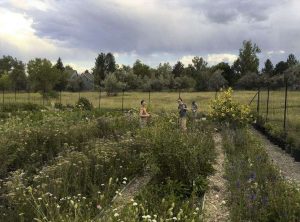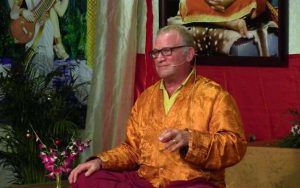Let the beauty we love be what we do. There are hundreds of ways to kneel and kiss the ground.
Rumi
Farming sustainably is a special form of bodhicitta in action. I have been teaching myself about regenerative farming from books and local farmers, as well as attending the recent sixth annual Soil Revolution Conference in Boulder, Colorado. There I met several fascinating people from all over the farming spectrum—from Big Ag commercial farmers to small-scale organic ones, all engaged in lively conversation around the necessary adaptation to methods that will sustain and regenerate the soil and therefore our crops, ourselves, and farm animals.
There are many parallels between sustainability in agriculture and the tenets of the Buddhadharma: to inherently realize our own true nature and the interdependence of all things. In both, the emphasis is on caring for and leading others toward awakening by example. Awakening is a broad term and can be defined in many ways, depending on the school, lineage, or tradition of Buddhism with which one engages.
In a relative sense, we all must awaken to the basic truth that we are completely dependent on products of the land, whether we source these locally or from afar. To sustain human life on Earth requires a deeper understanding of the interdependence of our own health with that of animals, soil, air, weather systems, and the plant kingdom. To deny relative interdependence is to cut off our own future survival. We are of, by, and for nature herself and always have been. Only in relatively recent times have we had the arrogance—and shortsighted greed—to deny this truth.
I therefore believe, as do many others, that regenerative farming will literally save the world—the interdependent spheres of life on Earth—if enough people put these practices into action in the very near future. To put it succinctly: “Regenerative agriculture is a nature-based approach that goes far beyond sustainability to continuously improve the entire ecosystem—soil, water, air, and animals.”* We all need this improvement to survive and reverse the desertification and species loss that we have created by poor methods that degrade the land.

Globally, farmers have always engaged with the same elements no matter where or to which culture they belong. Seasonal changes, rain, sunlight, soil quality, insects, seed quality, and the length of growing seasons are all common factors, though differing in quality and quantity. The human community is also an essential feature, as are animal species.
The Soil Revolution Conference, and others like it, are reinvigorating traditional and indigenous methods of crop diversification and rotation, as well as the rotation of growing areas and holistic management or integration of pests and livestock. In an impassioned article, Diné Nation member Lyla June Johnston writes about how all these so-called new sustainability practices are not new at all. Countless indigenous peoples have been employing these kinds of methods all along.
Now that regenerative agriculture is being better understood in mainstream culture and starting to be more properly funded by government agencies, indigenous societies—especially in the US—need to be financially subsidized for trying to sustain or restore ancestral methods. Violent and systemic colonization over centuries has deprived them of their lands and opportunities to engage in farming and animal husbandry, as well as mere survival.
As Johnston puts it:
. . . [we are] working to bring a new way of seeing the land, the water, the air, the fire [to the dominant culture]. My Nation isn’t about “sustainability.” We don’t just want to sustain an ecological place. We want to enhance it. We want to always leave it better than we found it. We do not practice sustainability, we practice enhance-ability.**
The contrasts between a colonizing mindset and an indigenous approach are well laid out in the following graphic:
To give examples of sustainable, regenerative agriculture, I will highlight some of the techniques used by Frith Farm in Maine, run by Daniel Mays and family, along with the apprentices they employ. Mays gave two fascinating talks at the Soil Conference, full of detailed instructions on how to develop and run a viable small-scale regenerative farm, complete with staff, animals, crops, and insects in harmony with the local community. Frith is a no-till, three-acre (1.2 hectare) market garden with intensive planting and soil development strategies. They have an active Community Supported Agriculture (CSA) farm share, an on-farm store, and sell wholesale to local natural food stores.
The basic premise of no-till farming is that intensive, repeated over-tillage eventually creates desertification. Examples abound worldwide.*** In the commercial tillage industry in the US, the practice “converts resources into pollution, and food is a byproduct.” By contrast, the aim of no-till agriculture is to “never see the soil.”**** The soil is always covered and protected, either by mulch, crops in progress, cover crops, or tarps, depending on time of year. These methods invigorate the soil microbiome and create a sense of wealth versus poverty by generating reinvestment potential instead of an extraction/profit mindset. Frith also provides a healthy working environment in which apprentices are valued stakeholders who also benefit from their labor. The result is a symbiotic greater good for all involved.

By using no-till, soil coverage methods, the soil is always diversifying and becoming richer as there is minimal disturbance to the healthy microbiome—it is in fact protected. Says Mays: “Soil health is human health.” Mays says that Frith has little issue with pests as they are left to be an intrinsic aspect of the whole. Cats reign in voles, and beneficial insects control damaging ones. They use few mechanized, fossil-fuel-powered vehicles to farm, relying instead on human power.
All these methods and the economics of running Frith Farm can be found in Mays’ book The No-Till Organic Vegetable Farm: How to Start and Run a Profitable Market Garden that Builds Health in Soil, Crops, and Communities (Storey Publishing 2020). The book gives a comprehensive guide to everything from establishing beds, seeding, irrigation, and weed control to harvesting, produce markets, and record-keeping. His philosophy is to share as much knowledge as possible freely, so that others can follow his tried-and-tested examples, benefiting farmers by his own trial and error process.
Of course, at least modest profits are required to sustain any venture, including running a small farm. But as Mays puts it: “I realize that finances are an important aspect of agricultural sustainability. But I would caution anyone who wants to farm for purely economic reasons. For me, the value of farm life is not measured in dollars but in the smell of the land after a summer rain; the feel of calloused hands, tired muscles, and sun-soaked skin; the community of organisms with whom life is shared; the taste and vitality of the fruits of our labor; and the sense of nourishing something greater than ourselves.”*****
May you find inspiration, as I have, in these resources, and perhaps even employ some techniques in your own small garden or local community farm!
* Luxury Fashion House, Burberry, Joins Land To Market Program (Savory Foundation Blog)
**Johnston, Lyla June. 2021. “Caring for Our Mother Earth.” Re:Generate journal, p.13.
*** The United Nations Decade for Deserts (2010-2020) and the Fight Against Desertification
**** Daniel Mays: Strategies for Successful No-till Vegetable Farming, Soil Revolution Conference, Boulder, CO, 12 August 2021.
***** The No-Till Organic Vegetable Farm: How to Start and Run a Profitable Market Garden That Builds Health in Soil, Crops, and Communities (Storey Publishing 2020), p.2.
See more
Soil Revolution
Traditional Native American Farmers Association (TNAFA)
Related features from BDG
Cultivating Wild: The Miracle of Dharma’s Garden!
Buddhism, Circa 2030
Right Mindfulness and Vegetable Gardens
Grow Your Garden: A Simple Practice in Reflection, Part One
For the Earth: Buddhist Environmental Thought and Activism
Planting the Seeds of Enlightenment
Is This Buddhism? The Oneness of Spiritual Liberation and Social Justice
















